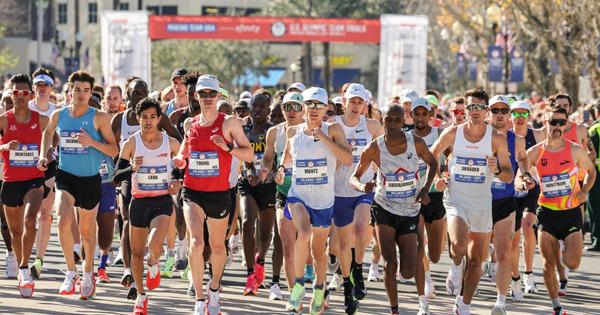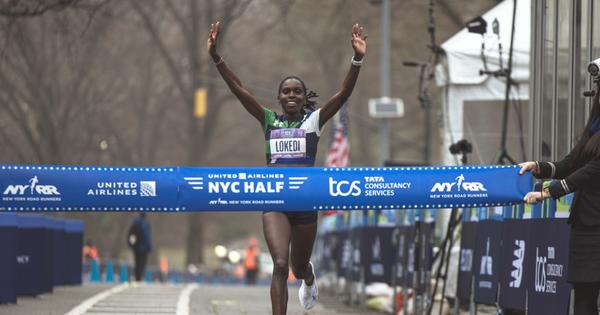By Paul Snyder
June 4, 2025
USATF has shared the qualifying standards for the 2028 Olympic Trials Marathon, and we have some thoughts.
First and foremost… there seemingly will be another Olympic Trials! That’s not exactly the sexiest take to start of this section, but ever since the financial albatross that was the Atlanta 2020 Trials, the continued existence of this race has felt far from guaranteed. So yeah, we’re going to go ahead and celebrate a little that the governing body tasked with selecting America’s Olympic team for track and field thinks highly enough of the Trials system to trot out qualification standards ahead of 2028: 2:16:00 for the men (1:03:00 in the half) and 2:37:00 for the women (1:12:00, likewise).
About those standards… because while the existence of this race going forward is one question, the second and related debate American closely follows: how big should the field size be, and why? Is this solely a selection race? A developmental carrot and/or stick? A celebration of the sub-elite side of the sport that rarely gets its flowers?
If the times look familiar, that’s because they mostly are— the one time that’s changed vis-a-vis 2024 is the men’s marathon standard, which got two minutes faster. In the most recent Trials, 139 of the 220 qualified runners would’ve still qualified under the new standard. It’s a tightening, but not a radical one.
These cut-offs—aimed at inviting fields of roughly 200 athletes per category—suggest USATF is trying to split the difference among all three objectives. And you know what? Good for them. Those are all admirable goals, and it’s hard to see how pursuing multiple could be truly detrimental to any single one…
…With one notable caveat. We’re back into “A” and “B” standard territory, which means that only athletes who attain the “A” standard will receive travel funding to the Trials. It’s a bit of a blow to those looking to recapture the free love hotel rooms of Woodstock Atlanta ‘20, but clearly USATF doesn’t want to make the prospect of hosting the Trials so financially onerous for a host city that nobody bids. While there’s no denying how badly the transfer of that strain onto the athlete will suck for some, but big picture, it’s a reasonable price to pay for the continued running of this event.
(This isn’t a takeaway, as much as it is a reminder and plea. Going significantly over budget for an event like this means overspending by something like several million dollars. Which is a lot, but we aren’t talking billions, or likely even tens of millions. So if any benevolent and quirky celebrities or financiers are reading this and want to help out a handful of less-well-off OTQ-types realize a dream, please give the good folks at USATF a shout. For instance, if any touring members of Public Enemy subscribe, please forward this email to Flavor Flav.)
One more nuts-and-bolts change to the qualifying rules is that the accepted entries list will be populated by chip time, rather than gun time. That’s great, and makes a ton of sense, particularly for women, who often get pushed back and bumped off the front of the starting line, and any first-time marathoner, who may lack the resume for race directors to award them elite entry. What’s a bit baffling is that this rule was not changed in the last cycle, given that there was a relatively high-profile instance in 2020 of a deserving athlete not being granted a qualification despite running minutes under the old standard of 2:45 via her chip time. Regardless, it’s a welcome improvement. Perhaps in 2028 we’ll send a CITIUS MAG Hat to the qualifier with the biggest disparity between their gun and chip times.
And finally, a take that’s less a take a more of a wishlist item/suggestion to steal from other sports. Any member of the 2016, 2020, or 2024 U.S. Olympic marathon squads who happen to be an active USATF member in good standing is already considered to possess the “A” standard. That means very-much-retired legends like Meb Keflezighi and Shalane Flanagan could line up if they want. It’s pretty rare in this sport for an athlete to receive their deserved adulation during the sort of retirement tour athletes in other sports tend to get. We may not be able to give them stadiums of fans all over the country and a year-long celebration of all they’ve done to inspire the next generation, but surely we can hit them with a tribute video on the starting line (set to M83’s “Outro” if Flav pays the licensing fee).
All in all, the 2028 standards reflect business as usual, for the most part. What USATF is saying, essentially, is that the Marathon Trials are a well-designed, albeit expensive, event and that the governing body is interested in replicating the successes of Orlando and Atlanta. That won’t rock the boat, but it keeps the ship afloat, which in this case is an undeniable victory.

Paul Snyder
Paul Snyder is the 2009 UIL District 26-5A boys 1600m runner-up. You can follow him on Bluesky @snuder.bsky.social.




